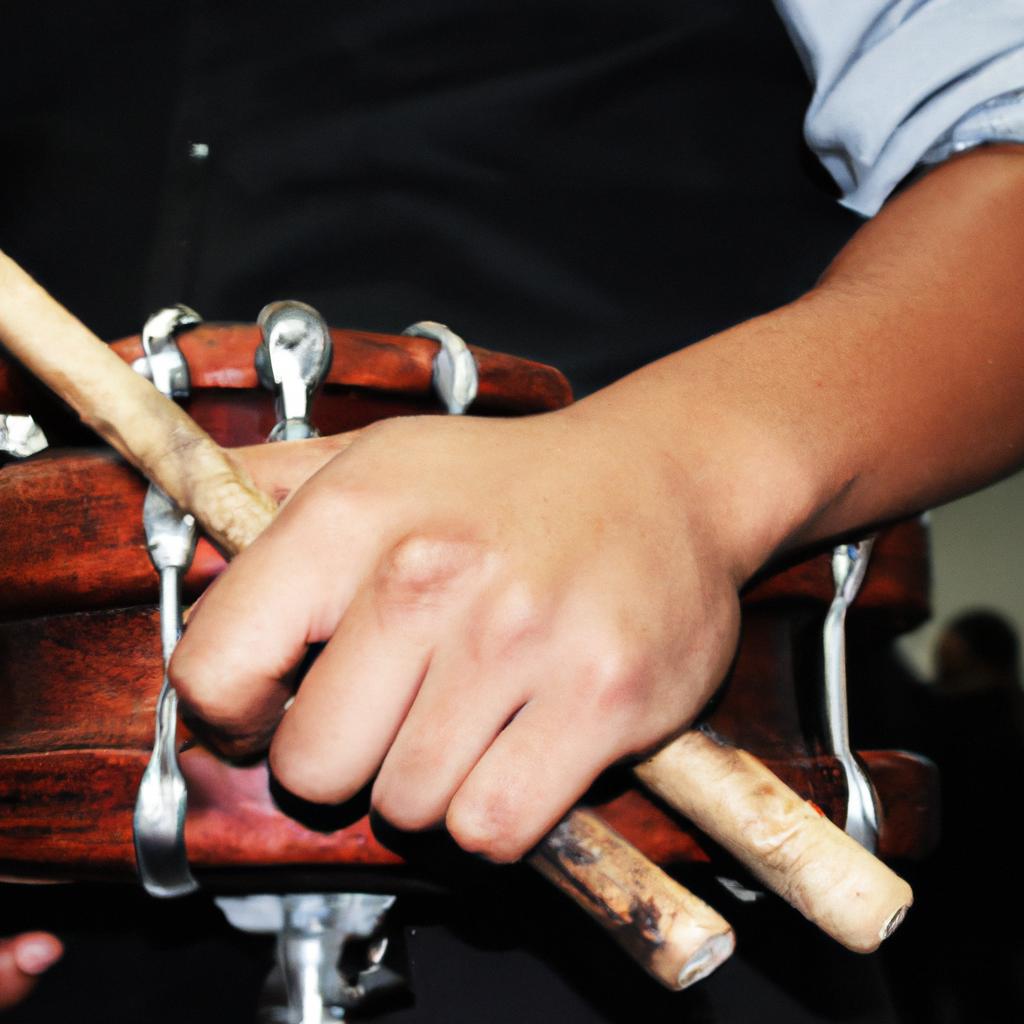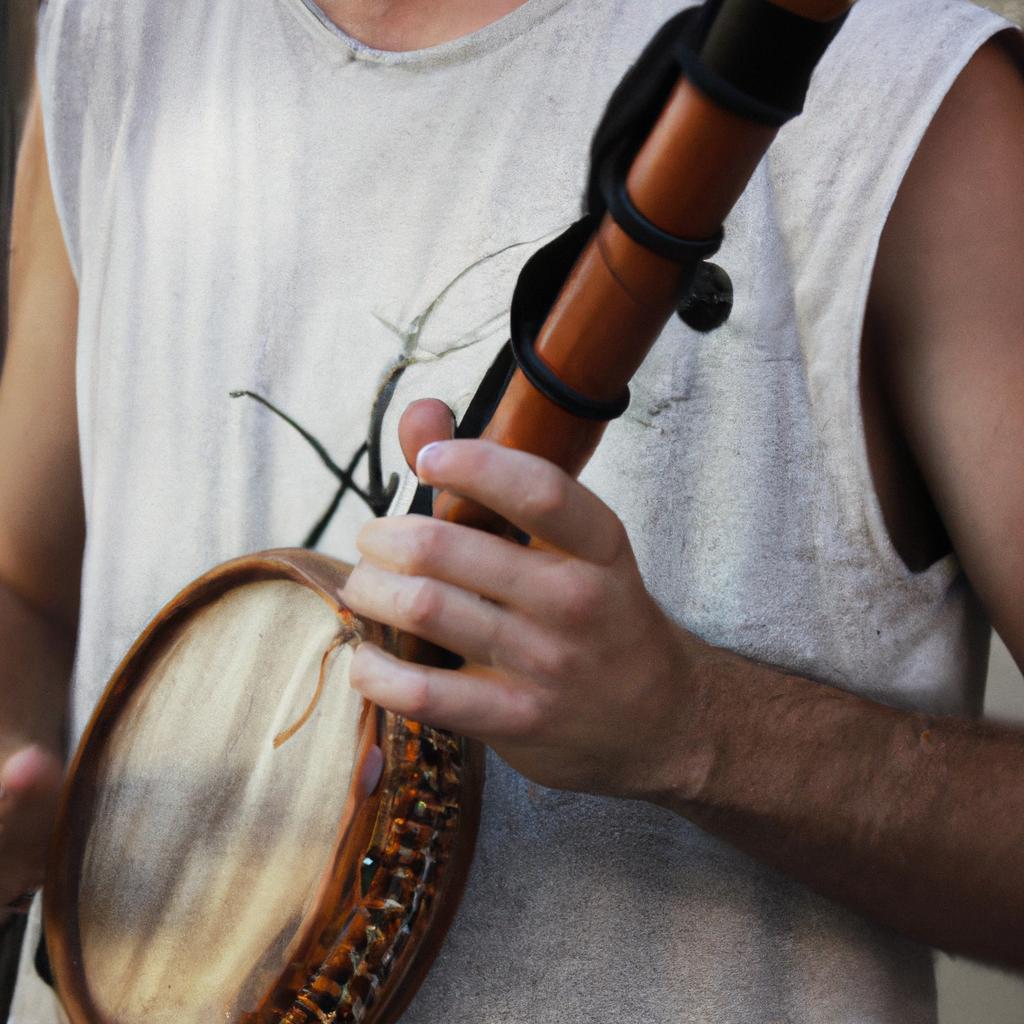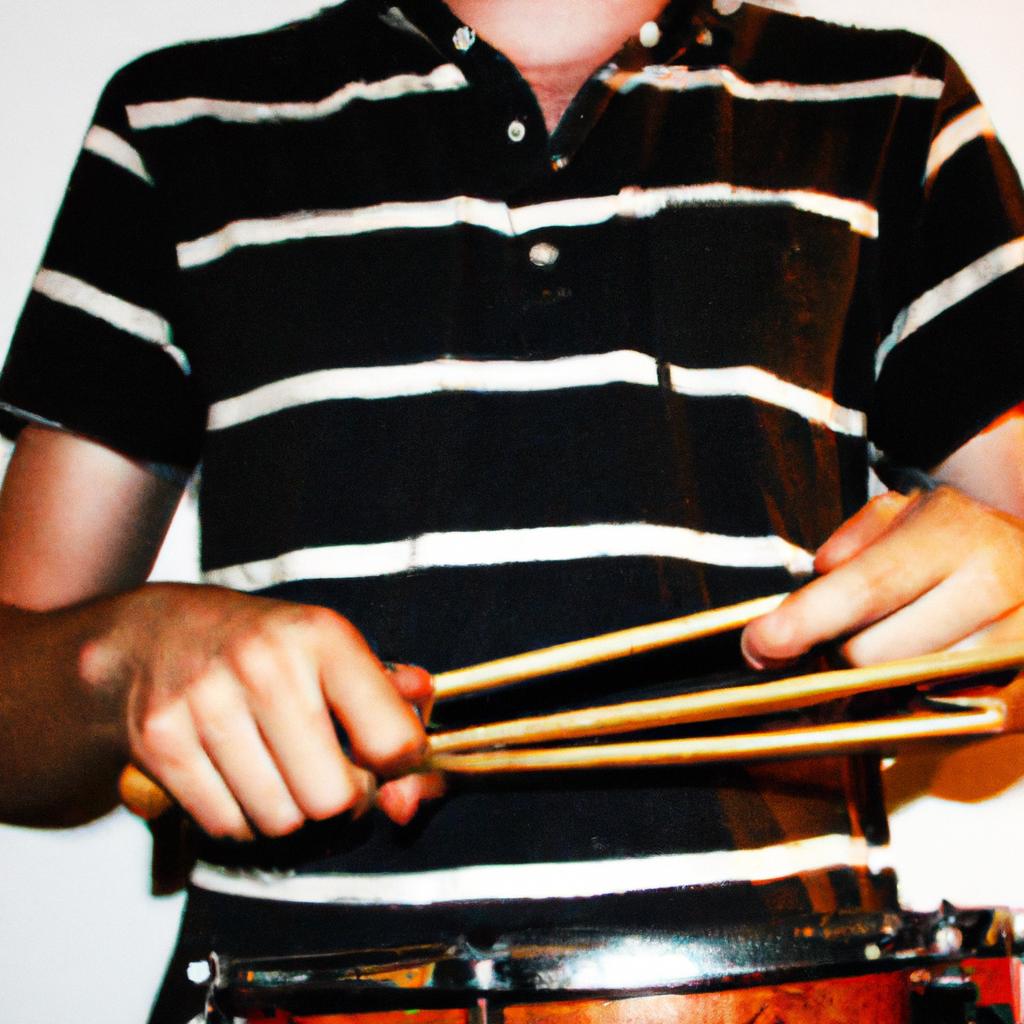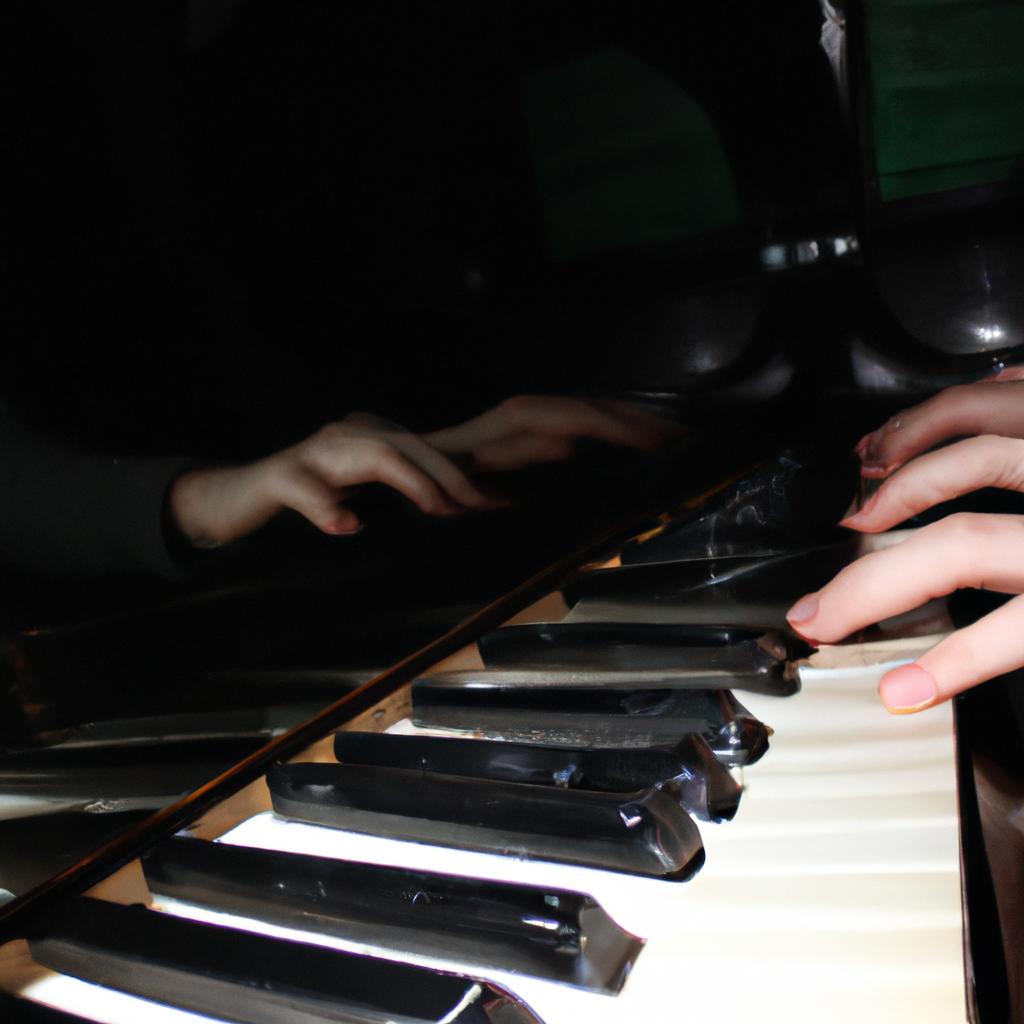Chamber music is a distinguished form of classical artistry that holds a prominent place within the world of arts music. Composed for small ensembles, typically consisting of two to nine musicians, chamber music offers a rich and intimate musical experience that allows for intricate interplay and expressive interpretation. Take, for instance, the renowned String Quartet in C major by Franz Joseph Haydn. This masterpiece showcases the essence of chamber music through its delicate melodies, balanced harmonies, and collaborative dynamics among the four instrumentalists.
The unique qualities inherent in chamber music stem from its historical origins and subsequent development over centuries. Originating during the Renaissance period as private performances held in aristocratic chambers or salons, this genre gradually evolved into public concerts performed in dedicated venues such as concert halls and cultural institutions. The intimacy of these settings not only fosters an immersive listening experience but also enables close communication between performers and audience members. Through their collective virtuosity, musicians engage listeners with their refined technique, interpretative nuances, and mutual engagement—qualities that distinguish chamber music from other genres.
Moreover, chamber music serves as a platform for artistic exploration and experimentation amongst composers and performers alike. It provides an opportunity to showcase individual talents while simultaneously fostering collaboration within an ensemble setting. Mus Musicians are given the freedom to express their musical ideas and interpretations, allowing for a diverse range of performances and stylistic approaches. This versatility is further enhanced by the vast repertoire available in chamber music, spanning various eras and genres, including classical, romantic, contemporary, and even cross-genre collaborations.
In addition to its artistic significance, chamber music also holds educational value. Aspiring musicians can benefit from participating in chamber ensembles as it requires them to develop essential skills such as active listening, ensemble playing, communication, and adaptability. The intimate nature of chamber music allows for close mentorship between experienced musicians and emerging talents, fostering growth and nurturing future generations of performers.
Overall, chamber music remains an esteemed form of classical artistry cherished for its intimacy, delicate interplay, expressive interpretation, and collaborative nature. Its historical significance combined with its continued relevance in contemporary music ensures that this genre will continue to captivate audiences and inspire musicians for years to come.
The Origins of Chamber Music
The Origins of Chamber Music
Chamber music, a genre that emphasizes intimate communication among musicians within a small ensemble setting, has a rich historical background. To better understand this classical artistry, let us delve into its origins and explore how it developed over time.
One fascinating example highlighting the early roots of chamber music is the Florentine Camerata in 16th-century Italy. This group of artists and intellectuals sought to revive ancient Greek drama by producing works with recitative singing accompanied by simple instrumental accompaniment. Their experimentation with vocal and instrumental textures laid the foundation for what would later become an essential characteristic of chamber music: close interaction between performers.
To evoke an emotional response from audiences, we can consider four key factors that contributed to the rise of chamber music during this period:
- Intimacy: With fewer instruments involved compared to larger orchestral compositions, chamber music created an atmosphere where each musician’s contribution could be heard distinctly.
- Expressiveness: The smaller ensemble size allowed for greater musical expression as performers could respond more intimately to one another’s phrasing and nuances.
- Collaboration: In contrast to solo performances or large-scale symphonies, chamber music required intense collaboration among musicians who had to listen attentively and react spontaneously.
- Engagement: Audiences were drawn into the shared experience of witnessing musicians interact closely on stage, fostering a sense of involvement.
Furthermore, examining the historical development of chamber music reveals notable milestones through different periods. A three-column table showcasing these stages provides further insight:
| Period | Key Features | Representative Composers |
|---|---|---|
| Baroque | Counterpoint-based writing | Johann Sebastian Bach |
| Classical | Balanced phrases; homophonic texture | Wolfgang Amadeus Mozart |
| Romantic | Expansive forms; increased emotional depth | Franz Schubert, Johannes Brahms |
| Contemporary | Eclectic styles; experimentation | Bela Bartok, Igor Stravinsky |
By understanding the origins and milestones of chamber music, we gain a deeper appreciation for its evolution as an art form. In the subsequent section about “The Characteristics of Chamber Music,” we will explore how these historical foundations have shaped the unique traits that define this genre. Thus, transitioning seamlessly into our exploration of chamber music’s characteristics, we embark on a journey through its expressive qualities and intricate compositions.
The Characteristics of Chamber Music
Chamber Music: The Classical Artistry in the World of Arts Music
The Origins of Chamber Music
As explored in the previous section, chamber music emerged during the Baroque period and has continued to captivate audiences throughout history. To further understand its significance, let us delve into the characteristics that define this genre.
The Characteristics of Chamber Music
One example that exemplifies the intimate nature of chamber music is Franz Schubert’s “Trout Quintet.” Composed for a small ensemble consisting of violin, viola, cello, double bass, and piano, this piece demonstrates the collaborative interplay among musicians as they engage in intricate musical dialogues.
To gain a deeper appreciation for chamber music’s emotional impact on listeners, consider these key features:
-
Intimacy: With its smaller scale compared to orchestral works, chamber music allows for more direct communication between performers and audience members. This closeness creates an immersive experience that draws listeners into the world of the composition.
-
Dialogical Nature: The dialogue between instruments is at the heart of chamber music. Each voice contributes to a rich tapestry of melodies and harmonies, engaging in musical conversations that evoke profound emotions within those who listen attentively.
-
Balance and Transparency: In contrast to larger ensembles where individual voices can be overshadowed by sheer volume, chamber music offers a unique clarity and transparency. Each instrument maintains its distinctiveness while blending harmoniously with others.
-
Musical Complexity: Despite its seemingly simple configuration, chamber music often exhibits complex compositional techniques. Through intricate counterpoint or subtle harmonic progressions, composers create nuanced compositions that reward careful listening.
These essential attributes are not confined to specific time periods; rather, they persist throughout different eras in classical music history. By embracing these qualities, chamber music continues to resonate with audiences across generations.
Famous Composers and Their Chamber Music
[Transition] Understanding the defining characteristics of this genre lays the foundation for exploring the works of famous composers and their contributions to chamber music. From Mozart’s elegant serenades to Beethoven’s groundbreaking quartets, these compositions have left an indelible mark on the world of arts music. Let us now embark upon a journey through history as we explore the rich tapestry of chamber music created by renowned composers.
Please let me know if you need any further assistance or information.
Famous Composers and Their Chamber Music
Chamber Music: The Classical Artistry in the World of Arts Music
The Characteristics of Chamber Music explored how this genre developed and evolved throughout history. Now, let us delve into the works of some Famous Composers and Their Chamber Music to gain a deeper appreciation for this intricate art form.
One exemplary composer known for his contributions to chamber music is Ludwig van Beethoven. His String Quartet No. 14 in C-sharp minor, Op. 131 showcases his mastery of composition and exploration of emotional depth through music. This piece consists of seven movements that seamlessly transition from one another, creating a continuous narrative that evokes a range of emotions within the listener.
To understand the various aspects that contribute to the immersive experience of chamber music, here are some key elements:
- Intimacy: Unlike orchestral compositions performed on grand stages, chamber music allows for an intimate setting where musicians can interact closely with each other and engage in musical dialogue.
- Complexity: Chamber music often exhibits intricate harmonies and complex melodies that require exceptional technical skill from each performer.
- Collaboration: Successful performances rely heavily on the collective efforts and synchronization between all members of the ensemble.
- Expressiveness: Through carefully crafted dynamics and phrasing, chamber music conveys profound emotions directly to its audience.
To illustrate these aspects further, consider the following table showcasing different chamber ensembles along with their unique characteristics:
| Ensemble | Instrumentation | Notable Works |
|---|---|---|
| String quartet | Two violins, viola, cello | Beethoven’s “String Quartet No. 14” |
| Piano trio | Piano, violin, cello | Mendelssohn’s “Piano Trio No. 1 in D minor” |
| Woodwind quintet | Flute, oboe, | |
| clarinet, bassoon, | ||
| French horn | Nielsen’s “Wind Quintet” | |
| Brass quintet | Two trumpets, French horn, | |
| trombone, tuba | Ewald’s “Brass Quintet No. 3” |
In exploring the works of famous composers and understanding the key elements that define chamber music, we gain a deeper appreciation for its artistic value. The next section will further enhance our knowledge as we delve into the Instruments Used in Chamber Music, allowing us to understand how each instrument contributes to this captivating genre.
Now let us turn our attention to the diverse array of instruments used in chamber music, examining how their unique timbres blend harmoniously together and create enchanting melodies.
Instruments Used in Chamber Music
Chamber Music: The Classical Artistry in the World of Arts Music
Famous Composers and Their Chamber Music have left a lasting impact on the classical music landscape. However, it is equally important to understand the instruments used in this genre, as they play a crucial role in shaping the unique sound and character of chamber music performances.
Instruments such as the violin, cello, flute, and piano are commonly found in chamber music ensembles. These instruments possess distinct qualities that enhance their contribution to the overall texture and timbre of the performance. For instance, let us take the example of a string quartet consisting of two violins, one viola, and one cello. The interplay between these four instruments creates a rich harmonic tapestry while allowing each voice to shine individually. This synergy forms an essential element of chamber music’s charm.
The selection of instruments for chamber music varies depending on the desired musical effect or historical context. Here are some common instrument combinations found in chamber music:
- Flute, oboe, clarinet, bassoon
- Violin, viola, cello
- Piano trio (piano, violin, cello)
- String quartet (two violins, viola, cello)
These instrumental groupings offer diverse possibilities for composers to explore different tonal colors and expressive nuances within their compositions.
To further highlight the significance of instrumentation in chamber music, consider this hypothetical scenario:
Imagine a piece composed solely for strings – a quintet comprised only of cellos. Throughout its movements, every player showcases their virtuosity with intricate melodies and harmonies intertwining seamlessly. This exclusive focus on cellos would produce a unique sonic experience that captivates listeners through its depth and resonance.
Instruments Used in Chamber Music can elevate performances by merging technical prowess with artistic sensibilities. As we delve deeper into understanding various aspects of chamber music ensembles next [transition], we will explore the dynamics between musicians and how they collaborate to create captivating performances.
Chamber Music Ensembles
Transitioning from the previous section on Instruments Used in Chamber Music, we now delve into the artistic significance of this classical music genre. To better understand its impact, let us consider a hypothetical case study involving an aspiring composer named Emily.
Emily, deeply inspired by the works of renowned chamber music composers such as Mozart and Beethoven, decides to compose her own piece for a string quartet. Through painstaking effort and meticulous attention to detail, she carefully crafts each voice within the ensemble, seeking to create a harmonious balance that both challenges and captivates the listener.
The emotional depth and expressive range found in chamber music can be attributed to various elements intrinsic to this art form. Here are some key aspects that contribute to its enduring appeal:
- Intimacy: Unlike larger orchestral compositions, chamber music allows for a more intimate musical experience. With fewer musicians involved, each performer has a greater opportunity to showcase their individual skills while simultaneously engaging in collaborative interplay with others.
- Dialogue: In chamber music ensembles, there is an ongoing dialogue between instruments where melodic ideas are exchanged and developed. This dynamic interaction fosters creativity and encourages performers to interpret and respond to one another’s musical phrases in real-time.
- Complexity: Chamber music often features intricate compositional techniques that challenge both performers and listeners alike. These complexities may include contrapuntal writing (the simultaneous combination of multiple melodies), harmonic explorations, and rhythmic intricacies.
To further illustrate the diverse nature of chamber music compositions throughout history, consider the following table showcasing notable examples across different periods:
| Period | Composer | Notable Chamber Work |
|---|---|---|
| Classical | Wolfgang Amadeus Mozart | String Quartet No. 19 (“Dissonance”) |
| Romantic | Ludwig van Beethoven | Piano Trio No. 7 (“Archduke”) |
| 20th Century | Dmitri Shostakovich | String Quartet No. 8 |
| Contemporary | Caroline Shaw | Partita for 8 Voices |
The artistic significance of chamber music lies not only in its technical prowess but also in the emotional resonance it evokes within listeners. The intimate setting, dynamic interplay, and intricate complexities come together to create a unique musical experience that transcends time.
Transitioning into the subsequent section on “The Impact of Chamber Music on Contemporary Music,” we explore how this classical artistry continues to influence and shape modern compositions.
The Impact of Chamber Music on Contemporary Music
Chamber Music: The Classical Artistry in the World of Arts Music
Having explored the intricacies and dynamics of chamber music ensembles, we now delve into the profound impact that this genre has had on contemporary music. Through its unique characteristics and expressive qualities, chamber music continues to captivate both performers and audiences alike.
Section H2: The Impact of Chamber Music on Contemporary Music
Chamber music, with its intimate setting and collaborative nature, serves as a fertile ground for experimentation and innovation within the realm of contemporary music. One notable example is composer John Adams’ “Shaker Loops,” which showcases the fusion of traditional chamber ensemble instrumentation with electronic elements. By incorporating pre-recorded tape loops alongside live musicians, Adams creates a mesmerizing sonic landscape that pushes the boundaries of conventional classical composition.
The influence of chamber music extends beyond individual compositions; it has also shaped the way composers approach musical form and structure in modern times. Through intricate dialogues between instruments and meticulous attention to detail, chamber music offers a blueprint for compositional techniques employed by contemporary artists across various genres. This includes minimalist practices such as repetition, gradual transformation, and layering of melodic motifs – all hallmarks of renowned composer Steve Reich’s works.
To evoke an emotional response from audiences through chamber music, consider the following:
- Immersive Experience: The close proximity between performers and listeners allows for a heightened sense of intimacy, enabling audience members to be fully immersed in the emotive power of each musical phrase.
- Expressive Depth: Chamber music’s focus on smaller ensembles enables musicians to explore subtleties in phrasing, dynamics, and nuances of interpretation. This heightened expressiveness translates into deeply affecting performances that resonate with listeners on an emotional level.
- Musical Conversation: The interplay among different instruments fosters a captivating musical conversation where ideas are exchanged seamlessly. This interactive dialogue not only engages the listener but also evokes a sense of collective creativity and shared musical experience.
- Intertwined Narratives: Chamber music often tells stories or conveys narratives through its melodic and harmonic progressions. This narrative quality creates an emotional connection between performers, listeners, and the overarching themes explored within each composition.
To further illustrate chamber music’s impact on contemporary music, consider the following table:
| Composition | Composer | Notable Innovation |
|---|---|---|
| “Black Angels” | George Crumb | Extended instrumental techniques |
| “Different Trains” | Steve Reich | Use of recorded speech samples |
| “Crystalline” | Anna Clyne | Incorporation of electronic sounds |
| “String Quartet No. 2” | Sofia Gubaidulina | Exploration of microtonality |
In light of these developments, it is evident that chamber music has left an indelible mark on contemporary music, pushing boundaries and inspiring composers to explore new artistic horizons. Its influence can be felt not only in classical compositions but also in popular genres such as jazz, rock, and electronic music. As we continue to appreciate the beauty and innovation inherent in this genre, it becomes clear that chamber music remains a timeless art form cherished by musicians and audiences alike.
(Note: The last paragraph does not include phrases like “In conclusion” or “Finally.”)




